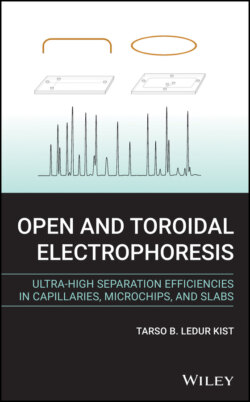Читать книгу Open and Toroidal Electrophoresis - Tarso B. Ledur Kist - Страница 19
1.1.7 Hydrophilicity, Hydrophobicity, and LogP
ОглавлениеHydrophilicity and hydrophobicity are qualitative terms that refer to chemical substances that, respectively, dissolve in water (strong affinity for water) or in non-polar substances (weak affinity for water). Solvation and the formation of hydrogen bonds are important processes involved in the dissolution of hydrophilic solutes in water (an environment rich in hydrogen bonds). On the other hand, no solvation or hydrogen bond formation occurs when attempting to dissolve hydrophobic (non-polar) substances in water. The dissolution of non-polar substances in non-polar solvents occurs because the positive entrophy change of the system (solventsolute) and the action of van der Waals forces among the hydrophobic solutes and the non-polar solvents. Note that van der Waals forces are much weaker than hydrogen bonds.
Microdrops of hydrophobic substances (e.g., vegetable oil) that are dispersed in water tend to irreversibly join (fuse) when random Brownian motion causes them to collide with each other. Each fusion event causes a sudden increase in the total number of hydrogen bonds in the given volume of water. Macrodrops are formed and at the end expelled from the bulk of the water, which again suddenly increases the total number of hydrogen bonds among water molecules. Note that the inverse reaction (converting a macrodrop of oil into microdroplets) is only possible with the input of a significant amount of energy (usually from vigorous mechanical stirring), as a large quantity of hydrogen bonds must be broken. Thus, it would be fairer to call water oleophobic instead of calling non-polar substances hydrophobic.
LogP (or CLOGP) is a well defined quantitative parameter that is related to the hydrophilicity and hydrophobicity of a chemical substance. It is a real number that goes from minus infinity to plus infinity () and is considered a fundamental parameter in ESTs and in many other fields (e.g., organic chemistry and pharmaceutical sciences).
Table 1.2 Examples of some LogP values. These are the average values of the most representative items of each data set. Measurements were taken at room temperature using pure water. The only exception was L-nicotine, which was measured at pH 10.3.
(Source: Data from DDBST GmbH, Oldenburg, Germany, www.ddbst.com.).
| Analyte | LogP | |
| Acetaldehyde | 0.43 | 1 |
| Acrylamide | 3 | |
| Aniline | 0.975 | 16 |
| Benzo[a]pyrene | 6.898 | 11 |
| Caffeine | 4 | |
| Dimethylnitrosamine | 2 | |
| L-nicotine | 1.39 | 1 |
The LogP of a chemical substance is defined as the decadic logarithm of its 1-octanol/water partition coefficient. The substance is dissolved in water or 1-octanol and then equal volumes of these solvents (one of which contains the substance under analysis) are placed in contact with each other and left to reach equilibrium. When equilibrium is reached the value of is calculated using the following equations:
(1.8)
Table 1.2 gives the LogP values of a few chemical substances. Such values are already used in structure–property correlations and quantitative studies of structure–activity relationships. As more LogP values become available, they will be used in pharmaceutical sciences, pharmanalysis, biochemistry, and analytical chemistry more frequently.
